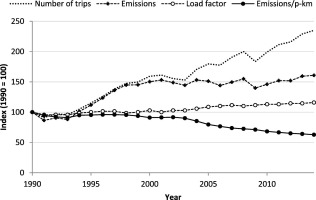当前位置:
X-MOL 学术
›
Environ. Impact Assess. Rev.
›
论文详情
Our official English website, www.x-mol.net, welcomes your
feedback! (Note: you will need to create a separate account there.)
Measuring greenhouse gas emissions from international air travel of a country’s residents methodological development and application for Sweden
Environmental Impact Assessment Review ( IF 9.8 ) Pub Date : 2018-09-01 , DOI: 10.1016/j.eiar.2018.05.013 Jörgen Larsson , Anneli Kamb , Jonas Nässén , Jonas Åkerman
Environmental Impact Assessment Review ( IF 9.8 ) Pub Date : 2018-09-01 , DOI: 10.1016/j.eiar.2018.05.013 Jörgen Larsson , Anneli Kamb , Jonas Nässén , Jonas Åkerman

|
Abstract Global civil aviation accounts for 4–5% of total greenhouse gas emissions and these emissions are increasing. In the absence of sufficiently effective global climate instruments, national instruments might be considered as a complement, in which case some way of allocating emissions from international air travel between countries is needed. The purpose of this paper is to develop an accounting method that reflects one country's greenhouse gas emissions from international air travel, and to apply this methodology to Sweden. The new methodology consists of three parts: the number of international air trips made by the country's residents; the average distance of these trips; and the greenhouse gas emissions per passenger km. For Sweden, data for 1990 to 2014 show an increase in the number of trips by Sweden's population of 3.6% per year, resulting in, on average, one international journey (round trip 5800 km) per capita in 2014. The average distance to the final destination has increased only marginally due to simultaneous growth in both long and short trips. However, global average greenhouse gas emissions per passenger km have decreased by 1.9% per year between 1990 and 2014. Because the increase in the number of their trips has outweighed the decrease in emissions per km, the total emissions from Swedish residents' international air travel have increased by 61% between 1990 and 2014. The total emissions from Swedish residents' air travel, including both CO2 and non-CO2-effects, were 11 Mt CO2 equivalents in 2014, which is the same level as the emissions from Swedish car traffic. This type of reliable data is important when designing policies and for getting public support for new policies.
中文翻译:

瑞典测量一国居民国际航空旅行温室气体排放的方法学发展与应用
摘要 全球民用航空占温室气体排放总量的 4-5%,而且这些排放量还在增加。在缺乏足够有效的全球气候文书的情况下,国家文书可能被视为一种补充,在这种情况下,需要某种方式来分配国家间国际航空旅行的排放量。本文的目的是开发一种能够反映一个国家在国际航空旅行中的温室气体排放量的核算方法,并将该方法应用于瑞典。新方法由三部分组成:该国居民的国际航空旅行次数;这些行程的平均距离;以及每客公里的温室气体排放量。对于瑞典,1990 年至 2014 年的数据显示,瑞典人口的出行次数增加了 3 次。每年 6%,导致 2014 年人均国际旅行(往返 5800 公里)一次。由于长途和短途旅行同时增长,到最终目的地的平均距离仅略有增加。然而,1990 年至 2014 年间,全球平均每乘客公里的温室气体排放量每年下降 1.9%。由于出行次数的增加超过每公里排放量的减少,瑞典居民国际航空旅行的总排放量1990 年至 2014 年间增加了 61%。 2014 年瑞典居民航空旅行的总排放量(包括 CO2 和非 CO2 影响)为 11 Mt CO2 当量,与瑞典汽车交通的排放量相同.
更新日期:2018-09-01
中文翻译:

瑞典测量一国居民国际航空旅行温室气体排放的方法学发展与应用
摘要 全球民用航空占温室气体排放总量的 4-5%,而且这些排放量还在增加。在缺乏足够有效的全球气候文书的情况下,国家文书可能被视为一种补充,在这种情况下,需要某种方式来分配国家间国际航空旅行的排放量。本文的目的是开发一种能够反映一个国家在国际航空旅行中的温室气体排放量的核算方法,并将该方法应用于瑞典。新方法由三部分组成:该国居民的国际航空旅行次数;这些行程的平均距离;以及每客公里的温室气体排放量。对于瑞典,1990 年至 2014 年的数据显示,瑞典人口的出行次数增加了 3 次。每年 6%,导致 2014 年人均国际旅行(往返 5800 公里)一次。由于长途和短途旅行同时增长,到最终目的地的平均距离仅略有增加。然而,1990 年至 2014 年间,全球平均每乘客公里的温室气体排放量每年下降 1.9%。由于出行次数的增加超过每公里排放量的减少,瑞典居民国际航空旅行的总排放量1990 年至 2014 年间增加了 61%。 2014 年瑞典居民航空旅行的总排放量(包括 CO2 和非 CO2 影响)为 11 Mt CO2 当量,与瑞典汽车交通的排放量相同.











































 京公网安备 11010802027423号
京公网安备 11010802027423号